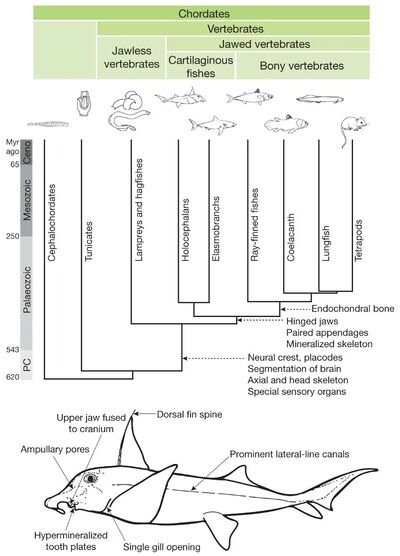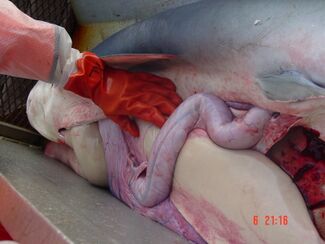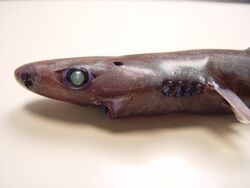Shark Evolution
Introduction

Sharks are long-bodied marine fish characterized by their cartilaginous skeleton, tall dorsal fin, and rough skin. Occupying every ocean on Earth, sharks are mostly carnivorous predators, with some larger species consuming plankton for sustenance. The evolution of sharks has been long and complex, beginning between 400 and 500 million years ago and spanning multiple mass extinctions to bring us today’s modern sharks.[1] As apex predators, they have evolved a wide variety of fascinating traits which have increased their fitness, allowing them to survive and reproduce at greater rates than their competition.
Sharks belong to the taxonomic class Chondrichthyes that contains all cartilaginous fish.[1] Specifically, they are one of two branches of the Elasmobranchii subclass, the other branch being skates and rays. The over 500 known shark species are then broken down into nine orders depending on the number of gill slits and dorsal fins, mouth location compared to eye location, snout elongation, and presence or absence of fin spines, anal fins, and nictating membranes. The orders are Hexanchiformes (Cow Sharks and Frilled Sharks), Pristiophoriformes (Sawsharks), Echinorhiniformes (Bramble Sharks), Squatiniformes (Angel Sharks), Heterodontiformes (Bullhead Sharks), Orectolobiformes (Carpetsharks), Lamniformes (Mackerel Sharks), and Carcharhiniformes (Ground Sharks) like the Whitetip Reef Shark (Fig 1).
Genetics
Evolution
With the earliest known shark fossils dating back roughly 450 million years ago, sharks are one of the oldest living groups of animals.[1] They were most prominent between 350 and 250 million years ago when Chondrichthian species made up over 60% of all fish species, before roughly 96% of all marine life was wiped out during the Permian-Triassic mass extinction. Certain early types of sharks survived however, with modern sharks and rays beginning to emerge and diversify around 200 million years ago, starting with cow and frill sharks of the Hexanchiformes.
Ancient sharks were characterized by weak elongated jaws, crescent shaped tails, caudal keels, and rigid pectoral fins.[2] One such example was the Cladoselache genus of cartilaginous fish that preceded modern sharks like the Mako and Great White. Another distinct example is the Helicoprion genus with its “tooth whorl” used to grip and saw through prey.
Sharks vs Bony Fish
Over the millenniums, sharks gradually diverged from their bony fish counterparts in several biological and anatomical way. As the names suggest, the most obvious difference lies in their skeletal structure. Bony fish evolved to have endochondral skeletal bone, which forms when bone replaces cartilage during development.[2] However, sharks maintained their cartilage structure, which is lighter and more flexible, allowing faster acceleration and agility when turning.

Sharks are also lighter and thus more efficient swimmers due to their lack of a swim bladder, which is replaced with oil storage in the liver to assist with buoyancy.[2] The only disadvantage of this trait is that sharks must constantly swim to prevent sinking. Another key difference is that shark muscles do not attach directly to the skeleton like bony fish, allowing greater flexibility when hunting or evading predators.[1] This is also true in shark jaws which can protrude to catch prey due to the flexible connective tissue anchoring them to the skull. Shark skin further distinguishes these animals as apex predators due to minute dermal denticles running from snout to tail that reduce drag in the water and thereby increase speed. However, their prioritization of forward acceleration means that sharks cannot swim backwards due to rigid pectoral fins.
Other traits that have made sharks successful predators include their unique teeth structure and electrosensing capabilities. While bony fish have a single row of teeth embedded in the jaw bone with slow replacement rate, sharks have multiple rows of teeth attached to a layer of cartilage above the jaw that are constantly replaced.[2] This allows them to aggressively pursue prey without fear of permanent or lengthy damage. An individual shark may rotate through tens of thousands of teeth within their lifetime. Sharks also have keen senses that enhance their ability to detect and catch prey. In addition to the five senses most animals have, sight, smell, hearing, taste, and touch, sharks have a sixth sense that allows them to detect the electrical field of their prey. For electroreception, sharks have specialized pore-like organs under and around their snout called ampullae of Lorenzini. Each receptor connects to a small canal of conductive fluid that can sense the faint electrical pulses sent when the muscles of prey contract and move ions.[1] Scientists also hypothesize that electrosensing allows sharks to pick up on Earth’s magnetic field or the geomagnetic features in the local seafloor, explaining their incredible ability to accurately navigate across long distances, even at great depths or with no visibility.
Finally, sharks evolved differently from bony fish in their style of reproduction. Bony fish employ R selection, meaning adults mature more quickly and externally fertilize by releasing large quantities of egg and sperm into their environment.[2] However, sharks use K selection, so adults are slow to mature and only produce a few well-developed young through internal fertilization. This method is advantageous because it conserves energy and gives offspring a higher chance of survival from birth.
Current Research on Shark Genetics
Recent studies on elephant sharks (Callorhinchus milii) have given insight into the emergence of gnathostomes, jawed vertebrates, in the evolutionary timeline. Elephant sharks have been identified as the slowest known evolving vertebrate, with synteny conservation that makes them ideal candidates for comparison with tetrapod genomes.[3] Data suggests that jawed vertebrates diverged from their jawless ancestors around the same time that paired fins and immunoglobulin-based adaptive immunity evolved. From there, gnathostomes divided into bony fish and cartilaginous fish (Fig 2). Through genomic sequencing, it was determined that cartilaginous fish, including sharks, lacked the genes to encode secretion of calcium-binding phosphoproteins, an essential component in bone development, driving their separation from bony fish.
Elephant sharks, as well as most cartilaginous fish, also differ from bony fish and other vertebrates in their adaptive immune system. Despite having polymorphic major histocompatibility complex class II molecules, they lack the canonical CD4 co-receptor and cytokines and cytokine receptors related to the CD4 lineage.[4] Because elephant sharks are the most distant relatives to humans that still have an adaptive immune response that relies on T-cell receptors and immunoglobulin antibodies, scientists analyze their genome sequences to identify differences in immune response that could benefit human medical treatments.
Microbiome

Like most animals, sharks constantly interact with microbes in their environment as well as in their own bodies. Although some microbes are harmful, disease-causing agents, many others are essential to gut health and overall survival of individuals. Unlike many terrestrial vertebrates, sharks are uniquely susceptible to the bacteria in their environment due to skin lesions from parasites, lacerations from prey or mates, the influx of seawater during mating, and the exposed capillaries of gills. [5] As a result, they have developed complex defense mechanisms to protect themselves from harmful pathogens, while still maintaining healthy levels of beneficial microbes.
When the bacterial flora of five common shark species were examined, isolates of the genus Vibrio made up the vast majority of the samples. Vibrios were found thriving in many different organs and tissues, as well as the surrounding sea water, indicating they are autochthonous or native to sharks.[5] Certain vibrios in the mouth and stomach helped breakdown starch, protein, and chitin, and vibrios in the gut improved digestion. Sharks also have a short intestine with a spiraled valve, giving them more surface area than bony fish to absorb nutrients (Fig 3). However, vibrios were often absent from the kidneys, liver, and spleen, suggesting a bacterial-host relationship that may impact shark physiology, specifically urea regulation. This was corroborated in a study that found increased toxin levels and high mortality rates in sharks with vibrios in these regions, especially in the kidneys.[6]
Researchers have also drawn comparisons between different shark species to determine how feeding behavior affects intestinal microbiome diversity and metabolic function. After comparing great white sharks with filter-feeding whale sharks, they found that diet actually had minimal influence on the diversity and abundance of fecal microbes and that microbial genera varied little between individuals of the same and different species.[7] It was discovered, however, that the microbiomes of external body niches like the eyes and skin were far more taxon-rich than internal niches. In fact, the gut microbiomes of many shark species displayed significantly less richness than most bony fish. [8] This again suggests that evolved defensive traits prevent microbes in the water column from heavily influencing the internal anatomy of sharks.
One such example of unique defense mechanisms is the microbiome of a shark's skin. Among others, the Psychrobacters bacteria inhibits aquatic fungal pathogens, allowing sharks to heal at far more rapid rates than other animals, including humans.[7] Despite being elusive and notoriously adverse to captivity, sharks have garnered more attention in recent years for their potential application to the study of human disease prevention and microbiome health.
Uniquely Adapted Sharks
Certain shark species have evolved unique traits that better equip them to survive and reproduce within their specific habitat and niche. Their traits distinguish them from the rest of the shark population and allow for unusual behavioral advantages. The below examples highlight particularly unique adaptations, while demonstrating the diversity in size, diet, habitat, and behavior that characterizes sharks worldwide.
Hammerhead Shark: Hammerhead sharks are perhaps the most recognizable type of shark with their distinct lateral head extension, called a cephalofoil, which evolved roughly 20 to 35 million years ago.[2] This makes the Sphyrnidae family, which contains eight species of hammerhead sharks, the most recent modern species to evolve. Over the years, many hypotheses have been proposed to explain this feature, including increasing vision for hunting, providing additional lift for swimming, and even allowing them to pin stingrays to the seafloor. However, the most widely accepted hypothesis is that the cephalofoil provides extra surface area for the ampullae of Lorenzini, enhancing their ability to detect the electrical fields of prey, thereby increasing hunting efficiency and success.

Bull Shark: Another well-known species, the Bull Shark is a highly successful predator that, along with a handful of other shark species, has evolved to survive in both saltwater and freshwater. While teleost fish imbibe water through the mouth and then excrete excess salt via the gills, most sharks hydrate through osmosis because their tissue contains more salt than the surrounding water, forcing water directly into the body through the skin.[2] This means that they are unable to survive in water with low salt content because the difference is too great, causing cell rupture and bloating from the great influx of water into the body. But bull sharks have overcome this through various adaptations including higher retention of salt in the body, kidneys that can force salt back into the bloodstream, and higher rates of urination to increase expulsion of fresh water. Having access to freshwater gives bull sharks greater access to prey and allows female sharks to give birth in protected estuaries, ensuring higher survival rates among juveniles.
Dwarf Lantern Shark: As the smallest known shark with a maximum length of roughly 8 inches, the dwarf lantern shark is already unique for its small size (Fig 4).[1] However, what sets it even farther apart is its bioluminescence. This species is a deep-sea animal and so lives in a very dark environment. Consequently, its ability to glow in the dark aids in schooling as well as locating mates. In females, stronger bioluminescence in the pelvic region indicates to males an increase in hormones and a readiness to mate. Scientists also believe this trait camouflages them from below as the bioluminescence makes them indistinguishable from the faint glow of the ocean’s surface. Their ability to thrive at such depths allows them to exploit a scarcely populated niche.
Conclusion
Although these ancient predators have overcome many threats to reach their modern dominance, they now face their greatest challenge in humans. Every year, roughly 100 million sharks are slaughtered, leading to a 75% reduction in global shark populations in the last fifty years alone.[1] Ironically, the evolutionary traits that have long made sharks apex predators have now made them prized targets for consumption. Around 75 million sharks alone are killed annually for the shark fin soup trade, a popular delicacy in many Asian countries. Shark finning is not only devastating to populations, but also inhumane and wasteful. Sharks are often finned alive and thrown overboard to die slowly, with roughly 95% of the shark’s body mass discarded.[2] Sharks are also hunted for their liver oil, specialized skin and teeth, as well as for sport. Millions of others are killed through other anthropogenic means including unsustainable fishing practices like drift nets, habitat destruction, and overfishing of critical prey populations. Because of their late maturity and high investment in offspring, shark populations are unable to keep up with these unprecedented threats.
There is hope, however. People are finally recognizing the critical role sharks play in the ocean’s ecosystems and have begun taking steps towards conservation. With concerted effort we have the chance to save these magnificent specimens of evolution and ensure many more millenniums of dominance.
References
- ↑ 1.0 1.1 1.2 1.3 1.4 1.5 1.6 Jorgensen S. Sharks: Ancient Predators in a Modern Sea. Firefly Books Limited; 2013.
- ↑ 2.0 2.1 2.2 2.3 2.4 2.5 2.6 2.7 Ebert D, Dando M, Fowler S. Sharks of the World: A Complete Guide. Princeton University Press; 2021.
- ↑ Venkatesh B, Lee AP, Ravi V, Maurya AK, Lian MM, Swann JB, et al. Elephant shark genome provides unique insights into gnathostome evolution. Nature. 2014 Jan;505(7482):174–9.
- ↑ Tan M, Redmond AK, Dooley H, Nozu R, Sato K, Kuraku S, et al. The whale shark genome reveals patterns of vertebrate gene family evolution. eLife. 2021 Aug 19;10.
- ↑ 5.0 5.1 Grimes DJ, Brayton P, Colwell RR, Gruber SH. Vibrios as Autochthonous Flora of Neritic Sharks. Systematic and Applied Microbiology. 1985 Sep;6(2):221–6.
- ↑ Grimes DJ, Stemmler J, Hada H, May EB, Maneval D, Hetrick FM, et al. Vibrio species associated with mortality of sharks held in captivity. Microbial Ecology. 1984 Sep;10(3):271–82.
- ↑ 7.0 7.1 Pratte ZA, Perry C, Dove ADM, Hoopes LA, Ritchie KB, Hueter RE, et al. Microbiome structure in large pelagic sharks with distinct feeding ecologies. Animal Microbiome. 2022 Mar 4;4(1).
- ↑ Givens CE. A FISH TALE: COMPARISON OF THE GUT MICROBIOME OF 15 FISH SPECIES AND THE INFLUENCE OF DIET AND TEMPERATURE ON ITS COMPOSITION [Graduate Dissertation. [University of Georgia]; 2012.]
Edited by Madeleine Campbell, student of Joan Slonczewski for BIOL 116 Information in Living Systems, 2022, Kenyon College.
